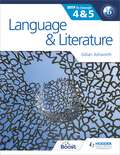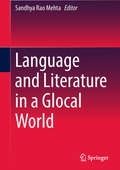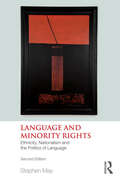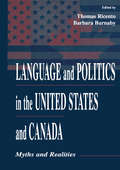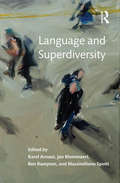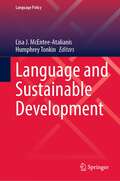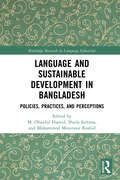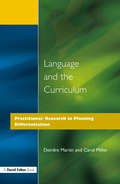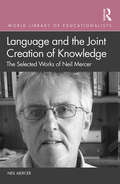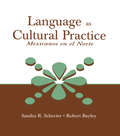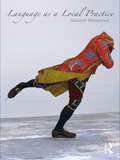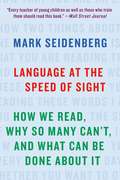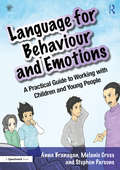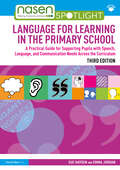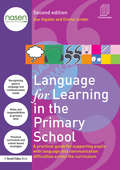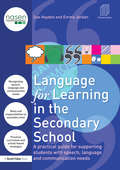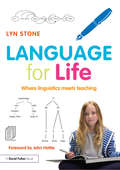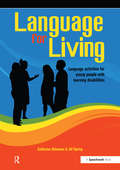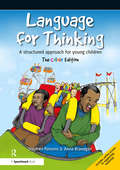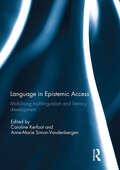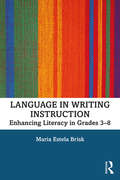- Table View
- List View
Language and Literature for the IB MYP 4 & 5: By Concept (MYP By Concept)
by Gillian AshworthThe only series for MYP 4 and 5 developed in cooperation with the International Baccalaureate (IB)Develop your skills to become an inquiring learner; ensure you navigate the MYP framework with confidence using a concept-driven and assessment-focused approach to Language and Literature presented in global contexts.- Develop conceptual understanding with key MYP concepts and related concepts at the heart of each chapter.- Learn by asking questions with a statement of inquiry in each chapter. - Prepare for every aspect of assessment using support and tasks designed by experienced educators.- Understand how to extend your learning through research projects and interdisciplinary opportunities.
Language and Literature in a Glocal World
by Sandhya Rao MehtaThis collection of critical essays investigates the intersections of the global and local in literature and language. Exploring the connections that exist between global forms of knowledge and their local, regional applications, this volume explores multiple ways in which literature is influenced, and in turn, influences, movements and events across the world and how these are articulated in various genres of world literature, including the resultant challenges to translation. This book also explores the way in which languages, especially English, transform and continue to be reinvented in its use across the world. Using perspectives from sociolinguistics, discourse analysis and semiotics, this volume focuses on diasporic literature, travel literature, and literature in translation from different parts of the world to study the ways in which languages change and grow as they are sought to be ‘owned’ by the communities which use them in different contexts. Emphasizing on interdisciplinary studies and methodologies, this collection centralizes both research that theorizes the links between the local and the global and that which shows, through practical evidence, how the local and global interact in new and challenging ways.
Language and Media: A Resource Book for Students (Routledge English Language Introductions)
by Rodney H. Jones Sylvia Jaworska Erhan AslanRoutledge English Language Introductions cover core areas of language study and are one-stop resources for students. Assuming no prior knowledge, books in the series offer an accessible overview of the subject, with activities, study questions, sample analyses, commentaries, and key readings—all in the same volume. The innovative and flexible 'two-dimensional' structure is built around four sections—introduction, development, exploration, and extension— which offer self-contained stages for study. Each topic can also be read across these sections, enabling the reader to build gradually on the knowledge gained. This revised second edition of Language and Media: Provides an accessible introduction and comprehensive overview of the major approaches and methodological tools used in the study of language and media. Focuses on a broad range of media and media content from more traditional print and broadcast media formats to more recent digital media formats. Incorporates practical examples using real data, including newspaper articles, press releases, television shows, advertisements (print, broadcast, and digital), blogs, social media content, internet memes, culture jamming, and protest signs. Includes key readings from leading scholars in the field, such as Jan Blommaert, Sonia Livingstone, David Machin, Martin Montgomery, Ruth Page, Ron Scollon, and Theo van Leeuwen. Offers a wide range of activities, questions, and points for further discussion. The book emphasises the increasingly creative ways ordinary people are engaging in media production. It also addresses a number of urgent current concerns around media and media production/reception, including fake news, clickbait, virality, and surveillance. Written by three experienced teachers and authors, this accessible textbook is an essential resource for all students of English language and linguistics.
Language and Minority Rights: Ethnicity, Nationalism and the Politics of Language (Language In Social Life Ser.)
by Stephen MayThe second edition addresses new theoretical and empirical developments since its initial publication, including the burgeoning influence of globalization and the relentless rise of English as the current world language. May’s broad position, however, remains largely unchanged. He argues that the causes of many of the language-based conflicts in the world today still lie with the nation-state and its preoccupation with establishing a 'common' language and culture via mass education. The solution, he suggests, is to rethink nation-states in more culturally and linguistically plural ways while avoiding, at the same time, essentializing the language-identity link. This edition, like the first, adopts a wide interdisciplinary framework, drawing on sociolinguistics, applied linguistics, sociology, political theory, education and law. It also includes new discussions of cosmopolitanism, globalization, the role of English, and language and mobility, highlighting the ongoing difficulties faced by minority language speakers in the world today.
Language and Politics in the United States and Canada: Myths and Realities
by Thomas Ricento Barbara BurnabyThis volume critically analyzes and explains the goals, processes, and effects of language policies in the United States and Canada from historical and contemporary perspectives. The focus of this book is to explore parallel and divergent developments in language policy and language rights in the two countries, especially in the past four decades, as a basis for reflection on what can be learned from one country's experience by the other. Effects of language policies and practices on majority and minority individuals and groups are evaluated. Differences in national and regional language situations in the U.S. and Canada are traced to historical and sociological, demographic, and legal factors which have sometimes been inappropriately generalized or ignored by ideologues. The point is to show that certain general principles of economics and sociology apply to the situations in both countries, but that differing notions of sovereignty, state and nation, ethnicity, pluralism, and multiculturalism have shaped attitudes and policies in significant ways. Understanding the bases for these varying attitudes and policies provides a clearer understanding of the idiosyncratic as well as more universal factors that contribute to tensions between groups and to outcomes, many of which are unintended. The volume makes clear that language matters always involve issues of culture, economics, politics, individual and group identities, and local and national histories. The chapters provide detailed analyses on a wide range of issues at the national, state/provincial, and local levels in both countries. The chapter authors come from a variety of academic disciplines (education, geography, journalism, law, linguistics, political science, and sociology), and the findings, taken together, contribute to an evolving, interdisciplinary theory of language policy.
Language and Power in Post-Colonial Schooling: Ideologies in Practice (Language, Culture, and Teaching Series)
by Carolyn McKinneyCritiquing the positioning of children from non-dominant groups as linguistically deficient, this book aims to bridge the gap between theorizing of language in critical sociolinguistics and approaches to language in education. Carolyn McKinney uses the lens of linguistic ideologies—teachers’ and students’ beliefs about language—to shed light on the continuing problem of reproduction of linguistic inequality. Framed within global debates in sociolinguistics and applied linguistics, she examines the case of historically white schools in South Africa, a post-colonial context where political power has shifted but where the power of whiteness continues, to provide new insights into the complex relationships between language and power, and language and subjectivity. Implications for language curricula and policy in contexts of linguistic diversity are foregrounded. Providing an accessible overview of the scholarly literature on language ideologies and language as social practice and resource in multilingual contexts, Language and Power in Post-Colonial Schooling uses the conceptual tools it presents to analyze classroom interaction and ethnographic observations from the day-to-day life in case study schools and explores implications of both the research literature and the analyses of students’ and teachers’ discourses and practices for language in education policy and curriculum.
Language and Superdiversity: Recombining Spaces, Times And Language Practices (Encounters Ser. #7)
by Jan Blommaert Karel Arnaut Massimiliano Spotti Ben RamptonA first synthesis of work done in sociolinguistic superdiversity, this volume offers a substantial introduction to the field and the issues and state-of-the-art research papers organized around three themes: Sketching the paradigm, Sociolinguistic complexity, Policing complexity. The focus is to show how complexity rather than plurality can serve as a lens through which an equally vast range of topics, sites, and issues can be tied together. Superdiversity captures the acceleration and intensification of processes of social ‘mixing’ and ‘fragmentation’ since the early 1990s, as an outcome of two different but related processes: new post-Cold War migration flows, and the advent and spread of the Internet and mobile technologies. The confluence of these forces have created entirely new sociolinguistic environments, leading to research in the past decade that has brought a mixture of new empirical terrain–extreme diversity in language and literacy resources, complex repertoires and practices of participants in interaction–and conceptual challenges. Language and Superdiversity is a landmark volume bringing together the work of the scholars and researchers who spearhead the development of the sociolinguistics of superdiversity.
Language and Sustainable Development (Language Policy #32)
by Humphrey Tonkin Lisa J. McEntee-AtalianisThis book addresses the importance of language in matters of sustainability and incorporating such concerns in implementing the UN’s Sustainable Development Goals (SDGs). Sustainable language policy must aim to include all groups, including language minorities and marginalized populations, such as refugees and aid recipients, in conditions that allow for their inclusion in making and implementing policy. The book brings together nine studies covering such topics as language and digital resources, sustainable and inclusive multilingual education, national language policy, and language in peacekeeping operations. A final chapter addresses the crucial intersection between sociolinguistics and economics, and the implications of this for development and the SDGs.
Language and Sustainable Development in Bangladesh: Policies, Practices, and Perceptions (Routledge Research in Language Education)
by Shaila Sultana Mohammod Moninoor Roshid M. Obaidul HamidThis book examines relationships between language and sustainable development in the context of Bangladesh. Following inclusive and multidisciplinary perspectives, these relationships are explored in mainstream education, teacher education, religious education and indigenous, ethnic minority and refugee settings. The contexts of development are also diverse which include the public sector, international non-government organisations, domestic work, tourism, and the environment.The book records voices of people from various linguistic, social, cultural, and demographic backgrounds, in urban, rural, and peripheral settings. It makes the language question visible in the manifold contexts of development where it has generally remained invisible. Giving visibility to language by referring to the Sustainable Development Goals (SDGs), the chapters embrace language and development in pluralistic ways and underscore their complex but undeniable relationships. The authors come from diverse backgrounds and bring plurality of genres, methods, insights, and implications.The volume is intended for students, academics, researchers, policy personnel, language practitioners, and other readers whose works and interests straddle language, development, and SDGs. It will benefit them by explicating language-sustainable development relationships in theoretical as well as practical ways, suggesting directives for policies and practices for linguistic and social justice, and equity and inclusion.
Language and the Curriculum: Practitioner Research in Planning Differentiation
by Carol Miller Deirdre MartinFirst Published in 1999. Routledge is an imprint of Taylor & Francis, an informa company.
Language and the Joint Creation of Knowledge: The selected works of Neil Mercer
by Neil MercerIn the World Library of Educationalists series, international experts themselves compile career-long collections of what they judge to be their finest pieces – extracts from books, key articles, salient research findings, major theoretical and practical contributions – so the world can read them in a single manageable volume. Readers will be able to follow the themes and strands and see how their work contributes to the development of the field. Language and the Joint Creation of Knowledge draws on the most prominent writing of Neil Mercer, covering his ground-breaking and critically acclaimed work on the role of talk in education, and on the relationship between spoken language and cognition. The text explores key themes, relating theoretical ideas to research evidence and to practical educational situations that improve children’s lives. Offering students and researchers a clear, accessible and up-to-date account of a sociocultural perspective on the relationship between spoken language and cognition, it explains one of the key themes in Neil Mercer’s work – that humans have uniquely evolved the capacity to think together, or ‘interthink’. Offering a crucial insight into the work of Neil Mercer, this selection showcases why his approach has become the dominant paradigm in educational research, and why it is increasingly influential in the psychology of teaching and learning. This unique collection of published articles and chapters, which represent the key themes and range of his research over the last 40 years, will be of interest to all followers of his work and any reader interested in the role of language in education.
Language as Cultural Practice: Mexicanos en el Norte
by Sandra R. Schecter Robert J. BayleyLanguage as Cultural Practice: Mexicanos en el Norte offers a vivid ethnographic account of language socialization practices within Mexican-background families residing in California and Texas. This account illustrates a variety of cases where language is used by speakers to choose between alternative self-definitions and where language interacts differentially with other defining categories, such as ethnicity, gender, and class. It shows that language socialization--instantiated in language choices and patterns of use in sociocultural and sociohistorical contexts characterized by ambiguity and flux--is both a dynamic and a fluid process. The study emphasizes the links between familial patterns of language use and language socialization practices on the one hand, and children's development of bilingual and biliterate identities on the other. Using a framework emerging from their selection of two geographically distinct localities with differing demographic features, Schecter and Bayley compare patterns of meaning suggested by the use of Spanish and English in speech and literacy activities, as well as by the symbolic importance ascribed by families and societal institutions (such as schools) to the maintenance and use of the two languages. Language as Cultural Practice: *provides a detailed account of the diversity of language practices and patterns of use in language minority homes; *offers educators detailed information on the language ecology of Latino homes in two geographically diverse communities--San Antonio, Texas, and the San Francisco Bay Area, California; *shows the diversity within Mexican-American communities in the United States--families profiled range from rural families in south Texas to upper middle class professional families in northern California; *provides data to correct the prevalent misconception that maintenance of Spanish interferes with the acquisition of English; and *contributes to the study of language socialization by showing that the process extends throughout the lifetime and that it is an interactive rather than a one-way process. This book will particularly interest researchers and professionals in linguistics, anthropology, applied linguistics, and education, and will be useful as a text in graduate courses in these areas that address language socialization and learning.
Language as a Local Practice
by Alastair PennycookLanguage as a Local Practice addresses the questions of language, locality and practice as a way of moving forward in our understanding of how language operates as an integrated social and spatial activity. By taking each of these three elements – language, locality and practice – and exploring how they relate to each other, Language as a Local Practice opens up new ways of thinking about language. It questions assumptions about languages as systems or as countable entities, and suggests instead that language emerges from the activities it performs. To look at language as a practice is to view language as an activity rather than a structure, as something we do rather than a system we draw on, as a material part of social and cultural life rather than an abstract entity. Language as a Local Practice draws on a variety of contexts of language use, from bank machines to postcards, Indian newspaper articles to fish-naming in the Philippines, urban graffiti to mission statements, suggesting that rather than thinking in terms of language use in context, we need to consider how language, space and place are related, how language creates the contexts where it is used, how languages are the products of socially located activities and how they are part of the action. Language as a Local Practice will be of interest to students on advanced undergraduate and post graduate courses in Applied Linguistics, Language Education, TESOL, Literacy and Cultural Studies.
Language at the Speed of Sight: How We Read, Why So Many Can't, And What Can Be Done About It
by Mark SeidenbergAccording to a leading cognitive scientist, we've been teaching reading wrong. The latest science reveals how we can do it right. <p><p>In 2011, when an international survey reported that students in Shanghai dramatically outperformed American students in reading, math, and science, President Obama declared it a "Sputnik moment": a wake-up call about the dismal state of American education. Little has changed, however, since then: over half of our children still read at a basic level and few become highly proficient. <p><p> Many American children and adults are not functionally literate, with serious consequences. Poor readers are more likely to drop out of the educational system and as adults are unable to fully participate in the workforce, adequately manage their own health care, or advance their children's education. <p><p>In Language at the Speed of Sight, internationally renowned cognitive scientist Mark Seidenberg reveals the underexplored science of reading, which spans cognitive science, neurobiology, and linguistics. As Seidenberg shows, the disconnect between science and education is a major factor in America's chronic underachievement. <p><p>How we teach reading places many children at risk of failure, discriminates against poorer kids, and discourages even those who could have become more successful readers. Children aren't taught basic print skills because educators cling to the disproved theory that good readers guess the words in texts, a strategy that encourages skimming instead of close reading. <p><p>Interventions for children with reading disabilities are delayed because parents are mistakenly told their kids will catch up if they work harder. Learning to read is more difficult for children who speak a minority dialect in the home, but that is not reflected in classroom practices. By building on science's insights, we can improve how our children read, and take real steps toward solving the inequality that illiteracy breeds. <p><p>Both an expert look at our relationship with the written word and a rousing call to action, Language at the Speed of Sight is essential for parents, educators, policy makers, and all others who want to understand why so many fail to read, and how to change that.
Language for Behaviour and Emotions: A Practical Guide to Working with Children and Young People
by Melanie Cross Stephen Parsons Anna BranaganThis practical, interactive resource is designed to be used by professionals who work with children and young people who have Social, Emotional and Mental Health needs and Speech, Language and Communication needs. Gaps in language and emotional skills can have a negative impact on behaviour as well as mental health and self-esteem. The Language for Behaviour and Emotions approach provides a systematic approach to developing these skills so that young people can understand and work through social interaction difficulties. Key features include: A focus on specific skills that are linked to behaviour, such as understanding meaning, verbal reasoning and emotional literacy skills. A framework for assessment, as well as a range of downloadable activities, worksheets and resources for supporting students. Sixty illustrated scenarios that can be used flexibly with a wide range of ages and abilities to promote language skills, emotional skills and self-awareness. This invaluable resource is suitable for use with young people with a range of abilities in one to one, small group or whole class settings. It is particularly applicable to children and young people who are aiming to develop wider language, social and emotional skills including those with Developmental Language Disorder and Autism Spectrum Disorder.
Language for Learning in the Primary School: A Practical Guide for Supporting Pupils with Speech, Language and Communication Needs Across the Curriculum (nasen spotlight)
by Sue Hayden Emma JordanThe third edition of Language for Learning in the Primary School is an indispensable resource, packed full of practical suggestions on how to support 5-11-year-old children with speech, language, and communication needs. Colour coded throughout for easy referencing, this unique book supports inclusive practice by helping teachers to: Identify children with speech, language, and communication needs (SLCN) Understand speech, language, and communication skills Consider roles and responsibilities at primary school Plan a differentiated and adapted curriculum Consider the language demands across subjects Adopt a whole-school approach Make use of a wide range of positive strategies to support children in the classroom Empower children to access the curriculum Fully revised and updated, Language for Learning in the Primary School, 3rd edition, comes complete with a wealth of photocopiable and downalodable resources, giving teachers and teaching assistants the confidence to help children with SLCN more effectively in mainstream settings. It will also be an extremely useful resource for speech and language therapists, specialist teachers, and educational psychologists.
Language for Learning in the Primary School: A practical guide for supporting pupils with language and communication difficulties across the curriculum (nasen spotlight)
by Sue Hayden Emma JordanLanguage for Learning in the Primary School is the long awaited second edition of Language for Learning, first published in 2004 and winner of the NASEN/TES Book Award for Teaching and Learning in 2005. This handbook has become an indispensable resource, packed full of practical suggestions on how to support 5-11 year old children with speech, language and communication difficulties. Colour coded throughout for easy referencing, this unique book supports inclusive practice by helping teachers to: Identify children with speech, language and communication needs (SLCN) Understand speech, language and communication skills Consider roles and responsibilities at primary school Plan a differentiated and adapted curriculum Consider the language demands across subjects Adopt a whole school approach Make use of a wide range of positive strategies Empower children to access the curriculum Language for Learning in the Primary School comes complete with a wealth of photocopiable resources, giving teachers and teaching assistants the confidence to help children with SLCN more effectively in mainstream settings. It will also be an extremely useful resource for speech and language therapists, specialist teachers and educational psychologists.
Language for Learning in the Secondary School: A Practical Guide for Supporting Students with Speech, Language and Communication Needs (nasen spotlight)
by Sue Hayden Emma JordanLanguage for Learning in the Secondary School employs the same easy-to-use format as the best-selling Primary version of this book but has been adapted to meet the specific needs of secondary school teachers. This indispensable resource is packed full of practical suggestions on how to support students with speech, language and communication difficulties. Colour coded throughout for easy referencing, this unique book supports inclusive practice by helping you to: Identify students with speech, language and communication needs Understand how language is processed Consider roles and responsibilities at secondary level Plan a differentiated curriculum Consider the language demands across the subjects Adopt a whole school approach Make use of a wide range of positive strategies Empower students to access the curriculum. Language for Learning in the Secondary School comes complete with a wealth of photocopiable resources and activities, giving teachers and teaching assistants the confidence to help students with speech, language and communication needs more effectively in mainstream settings. It will also be an extremely useful resource for specialist teachers, speech and language therapists and educational psychologists.
Language for Life: Where Linguistics Meets Teaching
by Lyn StoneThis new edition of the bestselling Language for Life shows how language can be mastered by children and how what they have learned can be carried throughout their lives.An indispensable guidebook for teachers, it delivers explicit, step-by-step English language instruction via lessons in syntax, grammar, morphology, etymology, and punctuation, and arms students with the mental skill of thinking about language. This in turn helps children learn much more easily from the language around them. New features for this edition include: an increased focus on the relationship between knowledge of parts of speech and morphology to proficiency as a writer creating a metalanguage between student and teacher that encourages clear two-way feedback an increased focus on knowledge-building using factual topics as exemplars. Language for Life is a proven programme that is built upon years of experience. Lyn Stone’s pragmatic and modern approach is supported by feedback from teachers and students alike who have attended her numerous classes and workshops. This book helps teachers: learn more about language structure, guide the development of skills to write accurately and in increasing volume, and support the emergence of clear and organised thinking for writing.Brimming with vital information suitable for both basic and advanced level students, this book is an essential tool for all teachers wishing to give their students the best preparation possible to meet the demands of the modern world. Photocopiable worksheets throughout the book put teachers in the position of linguistic expert, guiding students through an enriching journey of language discovery and creativity.
Language for Life: Where linguistics meets teaching
by Lyn StoneWe all recognise how important first impressions are, something often formed by how well we speak and write. Language for Life shows how language can be mastered by children and how what they have learned can be carried throughout their lives. This indispensable guidebook for teachers arms pupils with the mental skill of thinking about language. This in turn helps children learn much more easily from the language around them. This book delivers explicit, step-by-step English language instruction via lessons in syntax, grammar, morphology, etymology and punctuation. Language for Life is a proven programme that is built upon years of experience. Lyn Stone’s pragmatic and modern approach is supported by feedback from teachers and pupils alike who have attended her numerous classes and workshops. Language for Life turns important research findings into evidence-based, effective classroom practice. This book helps teachers: learn more about language structure guide the development of skills to write accurately and in increasing volume support the emergence of clear and organised thinking for writing help pupils reach their full potential as readers and writers. Brimming with vital information suitable for both basic and advanced level students, this book is an essential tool for all teachers wishing to give their pupils the best preparation possible to meet the demands of the modern world. Photocopiable worksheets throughout the book put teachers in the position of linguistic expert, guiding pupils through an enriching journey of language discovery and creativity.
Language for Living: Communication Activities for Young Adults with Learning Difficulties
by Catherine DelamainThis title features communication activities for young adults with learning difficulties. This unique collection of 180 enjoyable group activities aims to foster both the skills underlying communication, such as body language and awareness of others, and aspects of spoken language itself. The activities fall broadly within the Entry Levels 1-3 of the Skills for Life Core Curriculum, but can be used as a completely independent programme. The book addresses the needs of students with very varied skill levels, and includes some activities which can be used with non-verbal students. "Language for Living" has the following advantages: no formal assessment necessary; equipment not required or kept to a minimum; activities can be freely adapted to suit students' lifestyles and experience; activities are simple to organise, and easy to fit in to the daily programme of college, day or residential settings; photocopiable resource section; and CD-ROM for optional record-keeping and printable resources.
Language for Thinking: A structured approach for young children: The Colour Edition
by Stephen Parsons Anna BranaganThis photocopiable resource provides a clear structure to assist teachers, SENCOs, learning support assistants and speech language therapists in developing children's language from the concrete to the abstract. It is based on fifty picture and verbal scenarios that can be used flexibly with a wide range of ages and abilities. Quick, practical and easy to use in the classroom, this programme can be used with individual children, in small groups or can form the basis of a literacy lesson or speech language therapy session. Features: question sheets are carefully structured to promote children's development of inference, verbal reasoning and thinking skills; the three parallel assessments of spoken and written language can be used to assess each child's starting level and then to monitor progress; score forms and worksheets for each lesson are included. The book is particularly useful for children who are recognised as having delayed language skills, specific language impairment, Autism Spectrum Disorder (including Asperger's Syndrome), pragmatic language impairment or moderate learning difficulties. The 2nd Edition is now in full colour throughout and has been updated with a simplified introduction. All illustrations and worksheets will now be available online. Features: full colour throughout; new and revised illustrations; simplified introduction; online resources; illustrations and worksheets.
Language in Educational and Cultural Perspectives (Second Language Learning and Teaching)
by Barbara Lewandowska-Tomaszczyk Marcin TrojszczakThis book comprises 20 chapters that have been divided into two distinct parts: language in educational contexts and language in cultural contexts. The contributions included in this book are the outcome of the conference Contacts and Contrasts that was held in Konin, Poland, in 2021 (C&C2021). The contributions featured in the first part of the part of the book focus on various issues in the field of applied linguistics, in particular language education, second and foreign language learning as well as translator training. The second part of this edited collection features chapters devoted to a range of issues at the intersection of semantics, historical and contact linguistics, as well as literature.
Language in Epistemic Access: Mobilising multilingualism and literacy development
by Caroline Kerfoot Anne-Marie Simon-VandenbergenThis book focuses on how to address persistent linguistically structured inequalities in education, primarily in relation to South African schools, but also in conversation with Australian work and with resonances for other multilingual contexts around the world. The book as a whole lays bare the tension between the commitment to multilingualism enshrined in the South African Constitution and language-in-education policy, and the realities of the dominance of English and the virtual absence of indigenous African languages in current educational practices. It suggests that dynamic plurilingual pedagogies can be allied with the explicit scaffolding of genre-based pedagogies to help redress asymmetries in epistemic access and to re-imagine policies, pedagogies, and practices more in tune with the realities of multilingual classrooms. The contributions to this book offer complementary insights on routes to improving access to school knowledge, especially for learners whose home language or language variety is different to that of teaching and learning at school. All subscribe to similar ideologies which include the view that multilingualism should be seen as a resource rather than a 'problem' in education. Commentaries on these chapters highlight evidence-based high-impact educational responses, and suggest that translanguaging and genre may well offer opportunities for students to expand their linguistic repertoires and to bridge epistemological differences between community and school. This book was originally published as a special issue of Language and Education.
Language in Writing Instruction: Enhancing Literacy in Grades 3-8
by María Estela BriskAccessible and engaging, this book offers a comfortable entry point to integrating language instruction in writing units in grades 3–8. A full understanding of language development is necessary for teaching writing in a successful and meaningful way. Applying a Systemic Functional Linguistics (SFL) approach, María Brisk embraces an educator’s perspective, breaks down the challenges of teaching language for non-linguists, and demonstrates how teachers can help students express their ideas and create cohesive texts. With a focus on the needs of all students, including bilingual and English language learners, Brisk addresses topics necessary for successful language instruction, and moves beyond vocabulary and grammar to address meaning-making and genre. This book provides a wealth of tools and examples for practice and includes helpful instructional resources that teachers can return to time after time. Moving from theory to practice, this teacher-friendly text is a vital resource for courses in language education programs, in-service teacher-training seminars, and for pre-service and practicing English Language Arts (ELA) teachers who want to expand their teaching abilities and knowledge bases. This book features a sample unit and a reference list of instructional resources.
